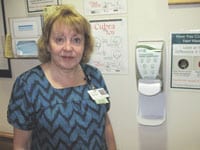Situation in Hand – Cooley Dickinson Takes High-tech Approach to Infection Control
As it builds a reputation for preventing infection, Cooley Dickinson Hospital isn’t giving itself a hand — but it’s certainly keeping an eye on them.
After the successful implementation in 2011 of a room-cleaning system that uses ultraviolet light to disinfect patient rooms (more on that later), CDH recently launched an electronic system for monitoring whether doctors, nurses, and other care providers are cleaning their hands before seeing patients.
Specifically, it has installed the DebMed GMS hand-hygiene-compliance system at hand-disinfecting stations in patient-care areas, hoping to get a picture of how diligent employees are about keeping germs in check. An electronic box at each station keeps a tally of how many provider-patient contacts are preceded — or not — by hand disinfecting.
“There’s a counter inside the alcohol hand sanitizer and soap dispenser; we put that counter on dispensers that service patient rooms. The count is sent via wi-fi to DebMed, which generates reports that they feed back to our department directors,” said Linda Riley, manager of Infection Prevention at the Northampton-based hospital.
“This is not Big Brother. It’s not tied to any badges; it’s just a unit rate.”
From there, departments are expected to discuss the findings at their staff meetings to develop goals and strategies for improving compliance rates, she said. “At all levels of the organization, we’re looking at hand hygiene and what we can do to improve.
“We’re just starting the process,” Riley added. “We’re at the phase of meeting with managers to make sure they understand what the expectations are.”
Infection prevention is a high-stakes endeavor for hospitals. According to the Centers for Disease Control and Prevention (CDC), hospital-acquired infections are the fourth-leading cause of death in the U.S., and are responsible for tens of billions of dollars annually in healthcare costs. DebMed’s technology, which had previously been tested only at hospitals in the Greensboro, N.C. area (where the company is based), is meant to reduce those numbers by providing real-time data on hand hygiene, one of the best weapons hospitals have against infection.
“They reached out to us because they knew we had already done work with ultraviolet light. They knew we were interested in improvement and using technology,” Riley said. “Electronic monitoring of hand hygiene is the next step in our journey toward zero infections.”
Seeing the Light
Over the past several years, Cooley Dickinson has taken a lead role in the region in infection prevention, from its virtual elimination of ventilatoracquired pneumonia to the implementation of the ultraviolet room-cleaning technology known as Xenex Px-UV.
“For the past three years, we’ve really been focusing on cleanliness,” Riley told HCN. “A lot of studies say our environment, the hospital environment, contains many, many germs, including some very bad, drug-resistant organisms, like MRSA, VRE, and C. diff [Clostridium difficile]. So we did a lot of improvement processes, and we’ve implemented CDC guidelines to prevent those infections.”
The C. diff problem is especially nasty, as about 165,000 hospitalized patients contract it annually, and about 9,000 of those die, according to the CDC. Since it starting disinfecting rooms with UV light between patient admissions in 2011, none of those deaths has occurred at CDH. In fact, the presence of the virulent germ dropped by 82{06cf2b9696b159f874511d23dbc893eb1ac83014175ed30550cfff22781411e5} in just the first four months after the introduction of Xenex.
“Not only did our rates go down per our initial hypothesis, but since we started using the UV light technology, no one has needed surgery or died from a hospital-acquired case of C. diff,” said Dr. Joanne Levin, medical director of Infection Prevention, at the time.
That dramatic change, Riley said, means that patients are now admitted to rooms that are essentially germ free but the longer they’re in the room, the more opportunities there are for germs to be introduced and spread. “And that’s where hand hygiene is important.”
“They reached out to us. They knew we were interested in improvement and using technology. Electronic monitoring of hand hygiene is the next step in our journey toward zero infections.”
A study conducted at Duke University Medical Center and published in Infection Control and Hospital Epidemiology showed that minimal improvements in hand hygiene lead to substantial savings. In fact, according to that study, a 1{06cf2b9696b159f874511d23dbc893eb1ac83014175ed30550cfff22781411e5} increase in compliance would result in annual savings of $39,650 for a 200-bed hospital. (CDH contains 140 patient beds.)
“We had been doing observations standing in the hall,” Riley said, adding that most observers reported a compliance percentage in the high 90s. “But we can’t see what happens behind closed doors. There are lots of opportunities in a room to clean your hands, but we can’t see that standing in the hallway. It’s also a pretty laborintensive way to get data, and you don’t get a statistically significant number of observations. The electronic counting gives us a real number of how many times people clean their hands.”
DebMed claims that group monitoring is recognized by infection-prevention experts as being more effective than other monitoring systems that track individuals’ actions — and can be seen by staff as punitive or as an invasion of privacy.
“This is not Big Brother,” Riley was quick to note. “It’s not tied to any badges; it’s just a unit rate, which means anyone who works in that unit contributes to the total. By doing this, the people who work in the unit will be working together and talking about hand hygiene and working toward goals for improvement. Hopefully this will contribute to the sense of teamwork and pride in the unit, as opposed to a feeling of Big Brother watching you.”
Aggressive Stance
Riley added that DebMed is also less expensive than a monitoring system tied to individual badges, while accomplishing the same thing.
DebMed — which calls hand hygiene the first line of defense in reducing infections — makes a similar argument. “Electronic monitoring,” the company claims, “captures 100{06cf2b9696b159f874511d23dbc893eb1ac83014175ed30550cfff22781411e5} of hand-hygiene events, providing a more accurate, cost-effective, and reliable way to measure healthcare workers’ hand-hygiene behavior than direct observation — the common, yet proven-to-be-unreliable practice that is still used today in the majority of U.S. hospitals.”
“People think we do all this stuff because we have a huge problem with infections, but we don’t. It’s because we want none. Our goal is zero.”
Riley said CDH is looking to improve its infection control in any way it can, and is committed to sharing its results with the wider healthcare community. “We’ve presented a couple papers on ultraviolet light at national conferences, and it’s going to be part of a research project published in the American Journal of Infection Control. I’m anticipating that, as we get more results, we’ll be presenting with this, too.”
Although Cooley Dickinson has dropped its patient-infection rates, she said, its goal remains total elimination, to whatever degree that’s realistic.
“People think we do all this stuff because we have a huge problem with infections, but we don’t,” she told HCN. “It’s because we want none. Our goal is zero. We want to make our environment as safe for patients as it can be, so our goal is zero. That’s why we’re being so aggressive.”


